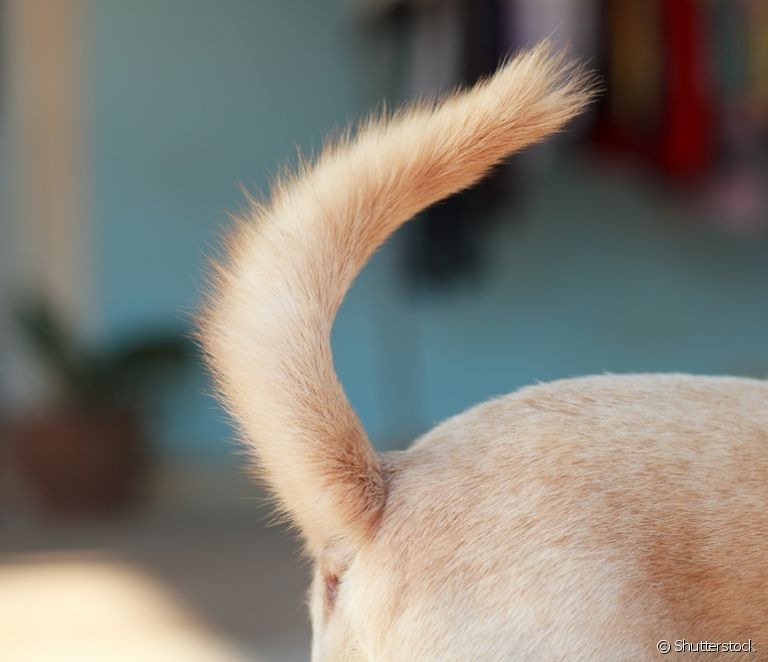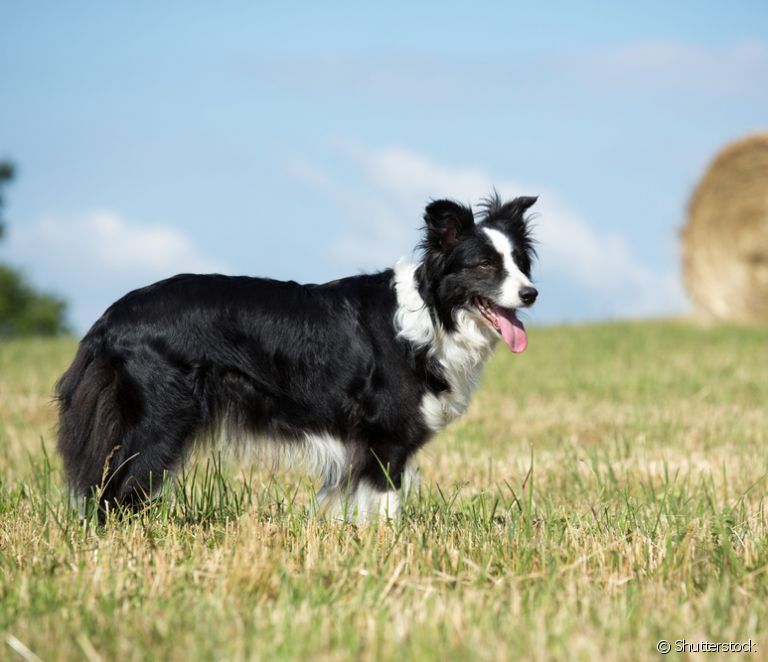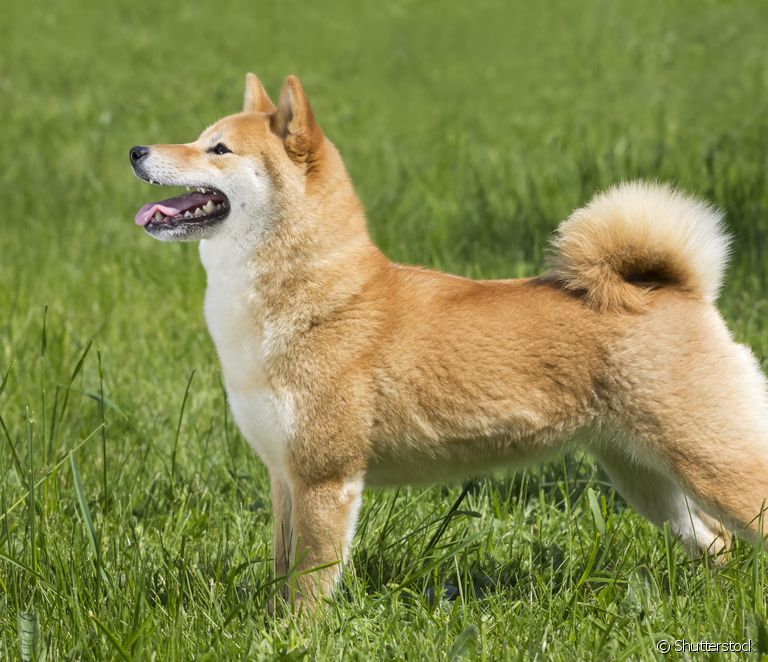Dog's tail: anatomy, curiosities, function and care... know everything!

Table of contents
Getting to know a dog's body is a great way to get closer and understand your four-legged friend even more. The movements of the dog's tail, for example, are a great way to better understand your pet, as they are part of canine body language. That is, it is a way that your dog finds to communicate with you. In addition, this is a very delicate region and one thatneeds some care so as not to harm the animal's health. With that in mind, we have prepared a very complete article full of information about the anatomy, function, care and curiosities about the dog's tail. See below!
Dog's tail: learn more about the anatomy of the region
One of the most distinctive features of a puppy is its tail. Depending on the breed, they can be long or shorter, bushy or sparsely furred. But one thing is common to all of them: the dog's tail is an extension of the spine, and, like the backbone, it is made up of several vertebrae, which are separated by spinal discs. This is what helps withThis explains why dogs can move their tails so quickly and intensely without hurting themselves.
Oh, and remember that the size of a dog's tail can be larger or smaller, depending on the breed? So, this means that the number of vertebrae can also vary, from 5 to 20, in general. These vertebrae, in fact, tend to be larger at the base and decrease in size as they approach the tip of the dog's tail.
Understand the functions of the dog's tail!
The dog's tail plays different important roles in the dog's routine. It helps maintain the animal's balance and is also one of the main forms of canine body language. In addition to the different types of barking, the dog can also communicate through the movements and position of his tail. So whenever you see a dog with his tail down or that stays down, you should be sure to check it out.wiggling their tail non-stop, it is important to keep in mind that there is a meaning behind it and it is usually a communication tool with humans and other animals.
In addition, a curiosity about the dog's tail is that they also perform another function that is even more specific in relationships between dogs. The tail of the animal is capable of releasing pheromones, chemicals that the dog exudes naturally and that can provoke different reactions in the animals of the same species close to it. That is, if the puppy is attracted to a female dog andwants to attract her back, it can release a sex pheromone that will help it get closer. These "smells" are produced by glands near the animal's anus.
Tail: dogs can suffer injuries in this area of the body
Because it is a very exposed region, the dog's tail is very vulnerable to fractures and injuries. So much so that a very common situation is when the dog catches the tail in doors and other places, a problem that usually leads to bruising and swelling in the place. In other cases, inattention is due to humans who can sometimes end up stepping on the dog's tail, hurting it.In addition, it is also possible that insect bites and contact with allergenic substances can cause a sore on the dog's tail.
If it is not a very serious injury, the situation does not require medical reinforcements and can be treated with ice compresses to reduce swelling and relieve discomfort in the area. If it is a serious fracture, it is important to take your puppy to the vet for a more rigorous analysis and for more specific treatment, which may include everything from painkillers, for example, to interventionssurgical, in cases where the dog may have broken a tailbone.
 Canine language: who has never wondered why a dog wags its tail?
Canine language: who has never wondered why a dog wags its tail?  The dog's tail is one of the main ways your four-legged friend communicates with you
The dog's tail is one of the main ways your four-legged friend communicates with you  Dog: low tail may indicate something is wrong with your friend
Dog: low tail may indicate something is wrong with your friend  There are different types of dog tails
There are different types of dog tails  The dog's tail may naturally position itself upwards, like the tail of Beagles
The dog's tail may naturally position itself upwards, like the tail of Beagles  Tail: dog may have its tail naturally down, like the Border Collie
Tail: dog may have its tail naturally down, like the Border Collie  Curly dog tails are also a charm, as is the case with the Shiba Inu
Curly dog tails are also a charm, as is the case with the Shiba Inu  Tail: Dogs can also have a shorter tail, like an English Bulldog.
Tail: Dogs can also have a shorter tail, like an English Bulldog.
The different types of dog tails
- Straight dog tail with natural downward position
This type of dog tail is what is part of the anatomy of dogs such as the Golden Retriever and the Border Collie. It means that the tail of these dogs is usually closer to the animal's legs, usually pointed downwards when it is in a relaxed state. Even in alert situations, they do not usually rise much above the spine.
- Straight dog tail with natural upward position
See_also: Canine language: what does your dog mean when he raises his front paw?Dogs such as the Yorkshire, Beagle and Chihuahua have their tails turned upwards, and not so close to their legs. These animals have great mobility and, unlike a Golden Retriever, are breeds that hardly have their tails turned downwards.
- Curly dog tail
See_also: Cavalier King Charles Spaniel: get to know all the characteristics of the small dog breedCommon in Shiba Inu and Shih Tzu dogs, the curled tail can cause some difficulties when communicating. They are usually located on the upper part of the dog's body in a spiral shape, having very little mobility. Therefore, dogs of these breeds look for other ways to express themselves, and it is important that humans are even more careful when it comes to communicating.interpret these dogs.
- Short dog's tail
Some breeds of dog are born with a very short tail, such as the English Bulldog. In these cases, communication ends up being quite impaired, but it does not mean that it is impossible to understand what the puppy wants to say.
Caudectomy: understand the dangers of cutting off the dog's tail
Caudectomy is a procedure used to cut the tail of animals, but it is prohibited in Brazil and can bring several problems to the health of the dog, if performed for aesthetic reasons. In addition to interfering with the animal's communication, it can also impair your pet's balance and affect blood vessels, nerves, tissues and skin.
The relationship between dog language and the dog's tail
Just as humans use body movements to communicate, dogs also use tail movements as a form of expression. Therefore, this part of the animal's body has become an important reference when it comes to interpreting canine body language. But how to do that? Well, to strengthen the bond with your four-legged friend, you need to understand that the position andThe movements of a dog's tail can indicate different situations. A wagging tail, for example, does not always mean that the dog is happy: depending on the way it moves and positions its tail, it can sometimes mean that the animal is feeling threatened, curious or afraid.
In addition, we need to understand that this is the way the dog communicates with the world, not just with humans. That is, sometimes the dog's tail will move in a specific way because it is his way of "talking" with other four-legged friends. How about understanding a little more how this works?
Canine body language: understand dog's tail movements
- Dog tail up and wagging intensely: usually means that the dog is happy and cheerful, and it is very common to happen when the guardian comes home after a long period on the street, for example. However, if your pet does this very often, it can also indicate anxiety and stress.
- Tail of dog up and swaying slowly: this is a movement that usually indicates that the puppy is curious about something.
- Tail of dog up and with small swings: this type of attitude is common when the dog wants to demonstrate imposition near another animal.
- Dog's tail standing up, projected outwards: means that the puppy is feeling threatened and ready to fight back any attack.
- Tail of dog standing still: This type of position is usually accompanied by a fixed gaze and rigid muscles, indicating that the dog is focused on something (probably an insect or bug nearby).
- Tail of dog standing rigid and at body height: this movement can be an indication of aggressive behavior, as it shows that the puppy is tense and ready to attack.
- Puppy with tail down and motionless: means that the dog is feeling afraid of something or has a problem.
- Puppy with tail between legs and uncertain movements: the animal is probably feeling insecure and has some situation bothering it.
- Puppy with tail down and head down: means that the dog may be hungry or sad.
Direction of the dog's tail also interferes with canine body language
According to a study published in the journal Current Biology Even the direction in which the dog moves its tail is an important factor when it comes to deciphering the message that animals want to convey. Thus, when the dog's tail is moving to the right, it is because the puppy wants to indicate positive feelings, such as joy and excitement. If the dog moves its tail to the left, the feelings are more negative, such as fear, anxiety and eveneven aggression.
The dog's tail should be analyzed in conjunction with the animal's posture
There's no point in getting to know your four-legged friend by looking at their tail alone. Although it's an important part of your dog's ability to communicate with you, you need to take other factors into account when trying to interpret canine language. So always pay close attention to your pooch's facial expression and body posture. The ears areUp or down, is their breathing calmer or more labored, is the dog barking, growling or making some kind of noise? These are important questions when it comes to understanding what your dog wants to tell you!

